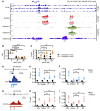ATRX silences Cartpt expression in osteoblastic cells during skeletal development
- PMID: 39744954
- PMCID: PMC11684799
- DOI: 10.1172/JCI163587
ATRX silences Cartpt expression in osteoblastic cells during skeletal development
Abstract
ATP-dependent chromatin remodeling protein ATRX is an essential regulator involved in maintenance of DNA structure and chromatin state and regulation of gene expression during development. ATRX was originally identified as the monogenic cause of X-linked α-thalassemia mental retardation (ATR-X) syndrome. Affected individuals display a variety of developmental abnormalities and skeletal deformities. Studies from others investigated the role of ATRX in skeletal development by tissue-specific Atrx knockout. However, the impact of ATRX during early skeletal development has not been examined. Using preosteoblast-specific Atrx conditional knockout mice, we observed increased trabecular bone mass and decreased osteoclast number in bone. In vitro coculture of Atrx conditional knockout bone marrow stromal cells (BMSCs) with WT splenocytes showed impaired osteoclast differentiation. Additionally, Atrx deletion was associated with decreased receptor activator of nuclear factor κ-B ligand (Rankl)/ osteoprotegerin (Opg) expression ratio in BMSCs. Notably, Atrx-deficient osteolineage cells expressed high levels of the neuropeptide cocaine- and amphetamine-regulated transcript prepropeptide (Cartpt). Mechanistically, ATRX suppresses Cartpt transcription by binding to the promoter, which is otherwise poised for Cartpt expression by RUNX2 binding to the distal enhancer. Finally, Cartpt silencing in Atrx conditional knockout BMSCs rescued the molecular phenotype by increasing the Rankl/Opg expression ratio. Together, our data show a potent repressor function of ATRX in restricting Cartpt expression during skeletal development.
Keywords: Bone biology; Bone development.
Conflict of interest statement
Figures






References
MeSH terms
Substances
Grants and funding
LinkOut - more resources
Full Text Sources
Miscellaneous

